Want your Christmas cactus bushier and bursting with blooms? Here’s a set of tips to turn your plant into the star of your festive décor.
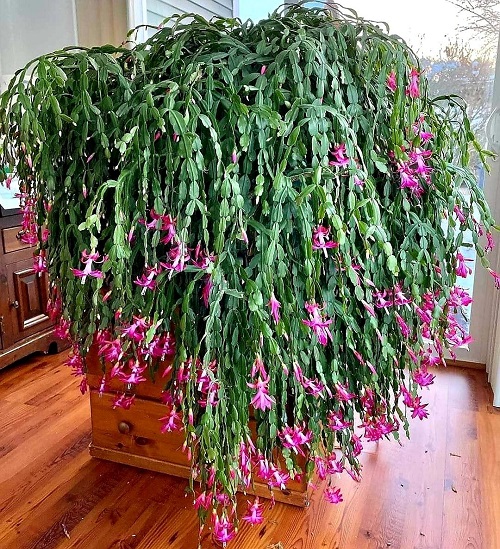
The Christmas cactus has flat, segmented stems that trail gracefully, with flowers at the tips. Unlike its desert cousins, it has little to no spines, which makes it an easy indoor favorite. It’s also long-lived—many thrive for 30+ years, and some even become family heirlooms. Here’s how to keep yours lush and eye-catching.
Tips for a bushier and lush Christmas Cactus
1. Dappled Light

The Christmas Cactus thrives in bright, indirect light. Keep your plant in an east- or west-facing window with dappled sunlight over them.
If only one side of your plant is growing, it means only that part is getting sunlight. So, rotate your plant regularly to ensure even growth. If natural light is scarce, use a grow light for a couple of hours daily to keep growth balanced.
Fact – Too much direct sun can heat the leaf surface to over 100°F, leading to burns. In their native Brazilian rainforests, these plants grow under tree canopies where the light is filtered.
2. Water your Cactus
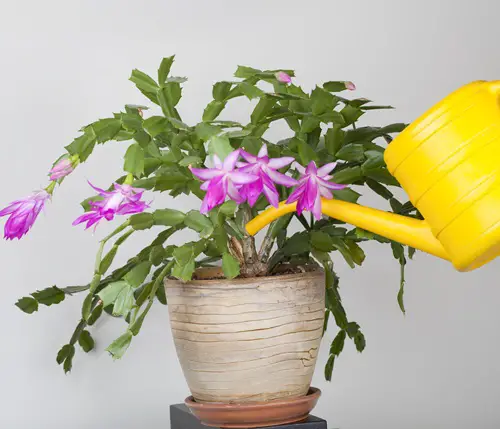
So, you think cacti don’t drink water, but the Christmas cactus does. Its stems are 90–95% water, which is why they plump up quickly when hydrated but also shrivel fast if neglected. Water when the top inch of soil feels dry. In summer, that’s usually once a week.
During spring and fall, every 2–3 weeks works, and in winter, once a month is enough. Cut back further when it’s blooming to let the plant rest.
Always keep it in a pot with drainage holes. Standing water causes root rot faster than you think.
3. Humid conditions
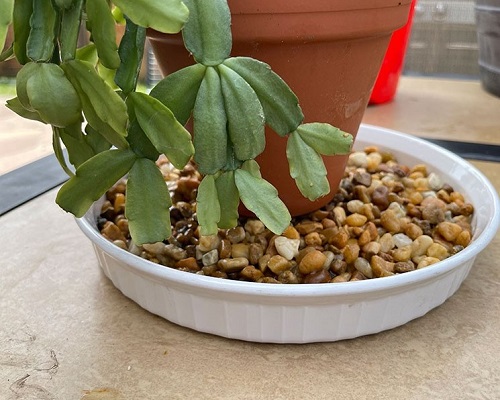
The Christmas cactus thrives in 50–60% humidity. If levels dip below 30%, it may dry out and fail to set buds. A humidifier helps, or you can place the pot on a pebble tray with water.
Light misting adds a moisture boost, but don’t overdo it—too much invites fungus. Grouping it with other houseplants is an easy way to create a natural humidity bubble.
4. Cool Down for Blooms
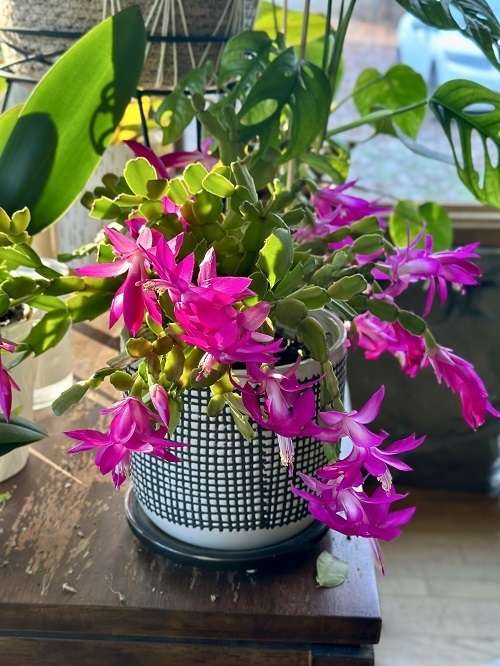
A little chill sets the stage for flowers. Drop temps to 50–55°F for about 6–8 weeks in fall to trigger buds. During this period, the plant also needs 12–14 hours of darkness daily, mimicking short winter days in nature.
Avoid sudden drafts or temp swings, though—otherwise, buds may drop before they even open.
5. Pruning
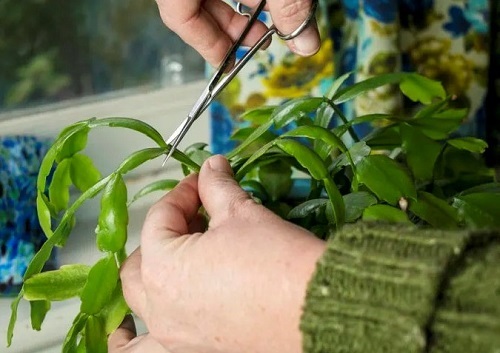
You can prune your Christmas cactus after the blooming period, typically in late winter or early spring. Avoid the dead or damaged stems.
A single healthy cactus can be pruned into 4–6 cuttings, giving you brand-new plants in just one season. You can prune with the help of sterilized scissors, and then plant the stems in soil or water.
6. Feed the Right Fertilizer
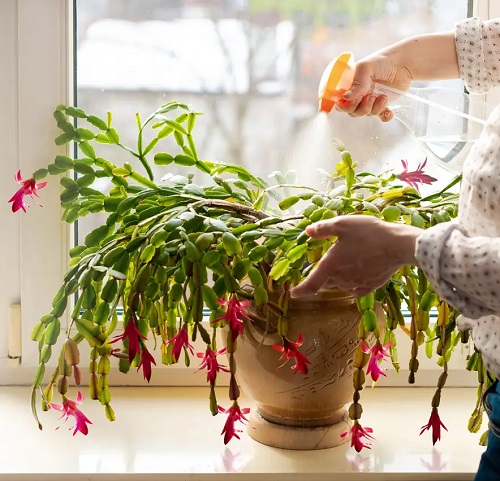
Fertilize once a month with water-soluble feed diluted to half strength. Look for a 5-10-5 NPK ratio—too much nitrogen grows leaves at the expense of flowers, while phosphorus boosts blooms.
You can also add compost tea or worm castings for a natural nutrient kick. Skip fertilizer during blooming, as it can stall flowers. To prevent salt build-up, flush the soil with plain water every few months.
7. Encourage Longer Blooms
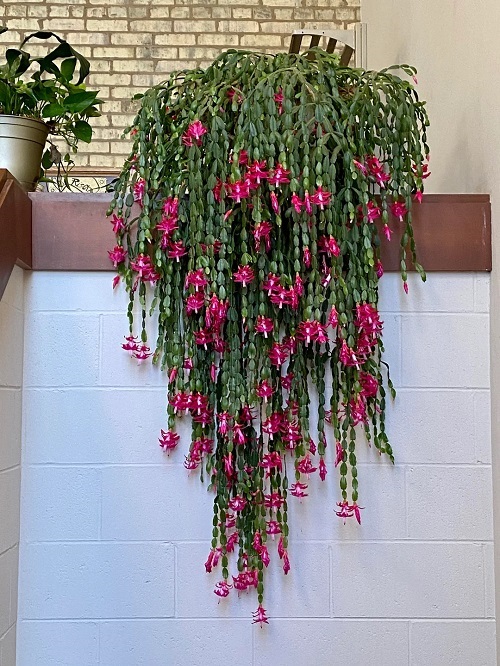
Under the right conditions, flowers appear in about 12 weeks, lasting 5–8 days each, with a healthy cactus blooming for up to 6 weeks straight.
For more flowers, give your cactus 14–16 hours of darkness for about 4 weeks and keep it in a cooler spot. Once buds appear, avoid moving the plant—shifts in light or temperature can make them drop.
Pro tip: Leave faded flowers on the plant for a while; it helps conserve energy for stronger blooms.
8. Propagating
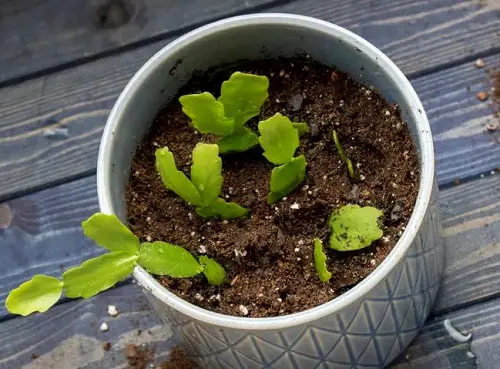
Propagate your cactus during spring or early summer, when the plant enters active growth, but not actively blooming. Don’t propagate your cactus during its blooming period, i.e., in late fall or early winter.
Christmas cactus can be propagated via seeds, stems, and roots.
Stem cuttings are the easiest and most reliable way. Just twist off a segment with 2–3 joints, let it callous for a day, and then plant it in moist soil. Cuttings usually root within 2 weeks and can start producing new segments in 3–4 months.
9. Pollination
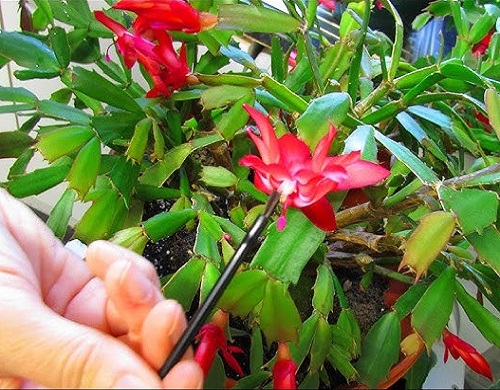
Christmas cacti can self-pollinate, but cross-pollination by hummingbirds or insects makes stronger blooms and seeds. Indoors, you can hand-pollinate by brushing pollen between flowers with a cotton swab or small brush.
Successful pollination produces red or purple berry-like fruits that can stay on the plant for up to a year—a festive bonus.
10. The Lemon Juice Hack

Here’s a trick that works fabulously when growth slows down—use lemon juice to balance soil pH. Christmas cacti love slightly acidic soil, but if yours is sitting in alkaline or neutral mix, it may sulk instead of thriving.
Just mix 1 tablespoon of fresh lemon juice (no sugar or additives) into 1 liter of water and pour it into the soil. If your soil is alkaline, apply it every two weeks; if it’s neutral, once a month is enough until the pH adjusts. Don’t use it if your soil is already acidic—you don’t want to go overboard.
This little boost not only corrects soil balance but also helps the plant absorb nutrients better and even wards off some soil-borne microbes. As the saying goes, “when life gives you lemons, give them to your cactus—it’ll thank you with lush growth!”
Christmas Cactus elevates holiday excitement. The flowers and stems are visually striking. Follow these tips and let us know in the comments about your Cactus.







